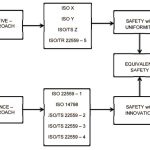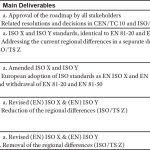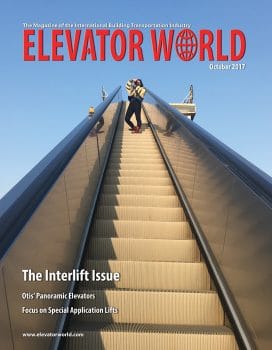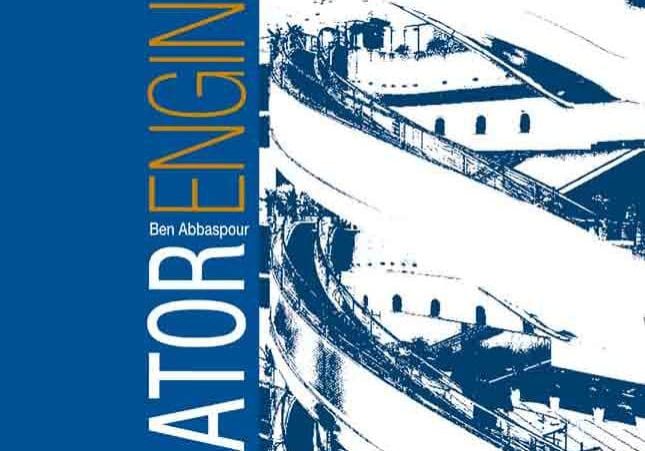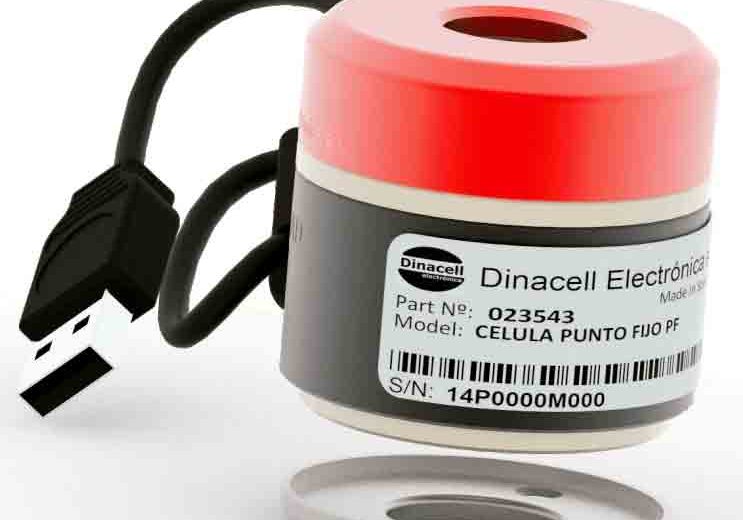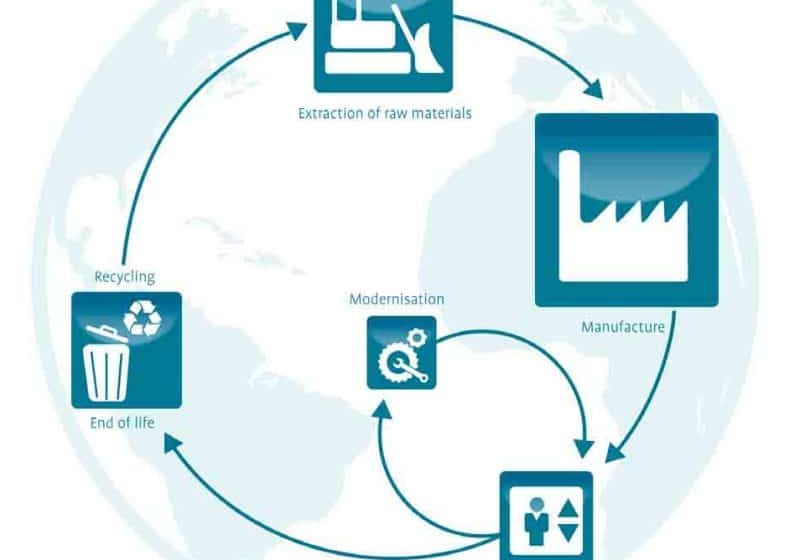Development of the ISO Prescriptive Elevator Code
Oct 1, 2017
An International Organization for Standardization (ISO) replacement for EN 81-20 and -50
This paper was presented at  Madrid 2016, the International Congress on Vertical Transportation Technologies, and first published in IAEE book Elevator Technology 21, edited by A. Lustig. It is a reprint with permission from the International Association of Elevator Engineers
Madrid 2016, the International Congress on Vertical Transportation Technologies, and first published in IAEE book Elevator Technology 21, edited by A. Lustig. It is a reprint with permission from the International Association of Elevator Engineers  (website: www.elevcon.com).
(website: www.elevcon.com).
A major step in worldwide elevator code harmonization is under way. This article summarizes the initiatives taken by ISO/TC 178 and CEN/TC 10 to create an ISO prescriptive elevator code. The two committees have agreed to base the new code on EN 81-20 and -50. Once the new ISO code is published and adopted, the EN 81-20 and -50 codes will be withdrawn.
1. Introduction
As the world economy becomes more global, the need for common safety levels and uniform standards becomes more evident. In recognition of this need, ISO/TC 178 initiated action to establish globally relevant standards for the elevator industry, including suites of codes that are both performance and prescriptive based. The objective of these suites of codes is to promote and improve the safety of elevators for the benefit of all stakeholders worldwide. It will improve global harmonization of technical requirements and facilitate technological innovation, while enabling the free movement of elevators and related components worldwide.
Several ISO/TC 178 resolutions have been approved, leading to the development of a joint and open approach within Working Group 4 (WG4), with strong support from the associations representing the elevator industry in North America, Europe and Asia-Pacific.
This article focuses primarily on the development of the ISO prescriptive-based elevator code, which is meant to be one global standard for elevators used as an identical national standard worldwide, and touches on the relationship to the complementary performance-based suite of codes that has already been developed.
2. Development of Performance-Based Codes
There has been great progress in the development of performance-based codes already. ISO 22559-1 Part 1: Global Essential Safety Requirements (GESRs) has been published. This international standard contains information comparing the GESRs to the Essential Health and Safety Requirements (EHSRs) of the European Lifts Directive (2014/33/EU). Supporting the GESRs is a set of parameters that can be used to verify conformance with the GESRs. These parameters are contained in ISO/TS 22559-2, Part 2: Global Safety Parameters (GSPs). The Risk Assessment Methodology contained in ISO 14798 is used to evaluate hazards and eliminate or reduce risk to ensure that the GESRs are met.
Rounding out the performance-based approach is a third-party conformity assessment process, consisting of two technical specifications, ISO/TS 22559-3, Part 3: Global Conformity Assessment Procedures (GCAP), and General Requirements and ISO/TS 22559-4, Part 4: Certification and Accreditation requirements. These two technical specifications create Global Conformity Assessments Bodies (GCABs), very similar to Notified Bodies in Europe or Accredited Elevator/Escalator Certification Organizations in North America, that would assess and verify conformance with the requirements in parts 1, 3 and 4, and provide a complete performance-based approach to elevator safety.
A similar approach is under development for escalators, which would have their own set of GESRs and GSPs.
3. Development of Prescriptive-Based Codes
A precursor to producing the prescriptive-based standards is a process called “convergence.” The objective of convergence was to facilitate the development of ISO prescriptive safety standards. A TC 178 task force (TFC) established by WG4 has studied opportunities for convergence of the requirements for five selected components (door locks, brakes, governors, safeties and buffers) in the three major codes. Initially, the TFC focused on the technical requirements, rather than the precise code language. The result of the convergence efforts by the TFC is to produce a Technical Report (ISO/TR 22559-5) to provide recommendations to assist National Committees to harmonize local and regional codes. When included in the various codes, the new recommendations would enable these components to be produced and sold globally. As technical requirements converge, it becomes easier to produce a global prescriptive-based standard.
During the process of revision of EN 81-1/-2, CEN/TC 10, the European Technical Committee responsible for the EN 81 series of codes for lifts (elevators) and EN 115 for escalators invited participants from outside Europe (China, South Korea, Japan and the U.S., as well as the Pacific Asia Lift and Escalator Association) to participate and provide comments. The input from an Ad Hoc Working Group (AH17) provided input from users of the EN 81 code outside Europe to ensure that the new EN 81-20/-50 codes were more aligned with these users’ needs and local requirements. These actions had the benefit of supporting the creation of ISO prescriptive safety standards.
Currently, there are three main prescriptive elevator codes used in the world:
- ASME A17/CSA B44 Safety Code for Elevators and Escalators, used in North America
- EN 81 series of standards used in Europe and other regions and countries
- Building Standard Law of Japan (BSLJ), plus the Japanese Industrial Standards (JIS)/Japan Elevator Association (JEA) series of standards used in Japan
These codes/standards contain prescriptive safety requirements, which, if followed in their entirety, lead to the design and installation of a safe elevator. While these codes may have some common roots, due to the independent development process over many years, as well as the unique regulatory environments in the countries and regions the codes are adopted in and enforced, the documents have significant differences in the detailed requirements, even though they provide a similar level of safety. These differences have resulted in the creation of barriers to trade.
In order to try to remove these barriers, the development of ISO prescriptive codes, which are meant to be global standards for elevators for use in all countries, was initiated. These codes are currently referred to as ISO X and ISO Y. The exact numbering of ISO X and ISO Y will be determined prior to publication.
Considering the current global relevance of EN 81-20/-50 and the wide participation from the non-CEN member countries in revision of the EN 81-1/-2 standards resulting in EN 81-20/-50, ISO/TC 178 decided to base the ISO X and ISO Y standards on the EN 81-20/-50 standards.
The ISO/TC 178 committee has developed and approved a roadmap to define the necessary steps, actions and timetable to develop and complete these prescriptive standards. See Table 1 for a simplified roadmap of the three-phase process of creation and ongoing revision of these standards.
4. Phase 1: Identical Adoption of EN 81-20/-50
The Preparation phase and Phase 1 of the process include identical adoption of EN 81-20 and -50 as ISO X and ISO Y, and creation of a regional Technical Specification as ISO/TS Z (see item 7 below) with a completion date of December. Several tasks need to be completed:
- ISO/TC 178 approves the proposed roadmap as a whole, based upon the input from all parties.
- Once approved by ISO/TC 178, the committee officially invites participation from CEN/TC 10, the EN committee responsible for the development of EN 81 standards, including EN 81-20 and -50.
- Having agreed to participate, CEN/TC 10 would be required to offer EN 81-20 and -50 to be adopted as identical ISO standards.
- CEN is required to grant copyright of EN 81-20 and -50 to ISO.
- ISO/TC 178 needs to launch a new work-item ballot to adopt EN 81-20 and -50 as identical standards ISO X and ISO Y, respectively. “Identical” means all clause numbers and technical requirements will be identical, but CEN reference standards will be converted to ISO or International Electrotechnical Commission reference standards and the Annex, which references the EU Lifts Directive, will be removed.
- Only minor editorial comments will be considered at the ballot stage. Any technical comments will be considered at the first revision of ISO X/Y.
- Due to the complexity of the codes in North America and Japan, and the number of differences between the North American and Japanese codes and EN 81-20/-50, an ISO Technical Specification (ISO/TS Z) document is needed to describe the differences between the ISO X and ISO Y and the current standards in use in those regions.
- There are differences in the scopes of the different regional codes. For example, the ASME A17.1/CSA B44 code covers both elevators and escalators. It is not possible to make the scopes of A17.1/B44 and the JIS standards identical to EN 81-20/-50. A statement indicating the equivalence in safety between ASME A17.1/CSA B44 and ISO X and ISO Y, where the scopes overlap, in combination with ISO/TS Z, will be included in the introduction to ISO X and ISO Y. A similar statement will be made for Japan regarding the BSLJ and JIS/JEA standards.
- ISO/TS Z will list the technical differences so users such as manufacturers outside North America or Japan may use ISO/TS Z in combination with ISO X and ISO Y to verify their product conformity with ASME A17.1/CSA B44 or JIS standards.
- ISO/TS Z will be launched for approval with the objective of publishing it at the same time as the ISO X and ISO Y standards.
5. Phase 2: Amendment of ISO X/Y
The work on the first amendment of those standards will commence once the ISO X and ISO Y standards have been approved and published. CEN/TC 10 has already prepared for the amendment of EN 81-20 and -50 upon their publication as part of the revision process for EN 81-1 and EN 81-2. To retain harmonization of the standards and keep ISO X and ISO Y identical to EN 81-20 and -50, CEN/TC 10 will direct its efforts to the revision of ISO X and ISO Y, with the objective of adopting those ISO standards as identical EN ISO standards. The following tasks need to be completed:
- ISO/TC 178 decides to amend the ISO X and ISO Y standards.
- ISO/TC 178 agrees that the amendment is to be based on the already prepared amendment to EN 81-20 and -50, with limited items to be considered.
- ISO/TC 178 proposes to amend those standards in cooperation with CEN/TC 10 using the Vienna Agreement (parallel approval process) and under CEN/TC 10 lead.
- CEN/TC 10 accepts the ISO/TC 178 proposal to lead the amendment and adopt ISO X and ISO Y standards as identical EN ISO standards. To assign the lead to CEN, agreement from the majority of ISO non-CEN members of ISO/TC 178 is required.
- CEN/TC 10 invites experts from ISO/TC 178 to participate in the amendment project.
- Amended ISO X and ISO Y are subject to simultaneous approval of both ISO TC 178 and CEN TC 10 members.
- After successful completion of the approval process, ISO will publish the amended ISO X and ISO Y, and, at the same time, CEN will publish those standards as EN ISO X and EN ISO Y.
- The EN 81-20 and -50 standards will be withdrawn, with a two-year transition period, by December 2022.
- At this stage, ISO/TS Z will likely remain essentially the same; however, the convergence process will commence to reduce the differences between ISO X/Y and JIS X/Y and ASME A17.1/CSA B44.
6. Phase 3: Regular Revisions (e.g., Every Three Years)
Once the first amendment to the ISO X and ISO Y standards have been published (December 2020), it is anticipated that those standards would continue to be revised at regular intervals (every three years) with the aim of reducing the regional differences in ISO/TS Z and converging them with the ISO X and ISO Y standards, whenever possible for those areas where scopes overlap. The following tasks need to be completed:
- ISO/TC 178 decides on a revision program for the ISO X and ISO Y standards.
- ISO/TC 178 determines whether to carry out the revision under ISO lead or under CEN lead.
- The main objectives of the revision are to maintain the ISO X and ISO Y standards to the state of the art, as well as the continued reduction of the regional differences outlined in the ISO/TS Z.
- The first revision is scheduled for publication in December 2023, and the second revision is scheduled for December 2026.
7. Final Result
The convergence process would continue with continued reductions of the regional differences outlined in the ISO/TS Z such that, over time, the content of ISO/ TS Z is minimized.
The final result would be a single set of ISO prescriptive standards for elevators, ISO X and ISO Y, applied globally. Of course, ASME A17.1/CSA B44 and JIS standards will continue to be used while their content is aligned with ISO X and ISO Y (with the exceptions of regulatory constraints, scope differences, building code requirements, etc). ISO/TC 178 will assign the management of these standards to an appropriate Working Group, as well as establish relevant procedures, including an interpretation process.
8. What Are the Benefits of ISO Prescriptive Codes?
The completion of the ISO X and ISO Y codes will provide a prescriptive-based approach to elevator safety, complementing the performance-based approach described above. Combined, the two approaches will provide common global safety standards for elevators. If adopted in all countries, manufacturers and suppliers will be able to produce and install products meeting one uniform safety standard anywhere in the world. Products could be certified and tested once, and authorities will be assured that the certifying body was qualified and accredited to a global, comprehensive conformity assessment standard.
Manufacturers will have a choice of conforming to a single prescriptive code for standard products or a single performance-based code for innovative products. Ultimately, improved global safety will benefit public and worker safety, as well as all stakeholders in the industry. The diagram shown in Figure 1 shows the two-tier approach to elevator safety, following either the prescriptive- or performance-based approach.
Acknowledgements
I would like to thank the members of ISO TC 178, the members of WG4 and, particularly, the members of the TFC, who contributed to the development of the documents described in this paper, as well as to the content of this paper itself.
- Figure-1
- Table-1
Get more of Elevator World. Sign up for our free e-newsletter.
